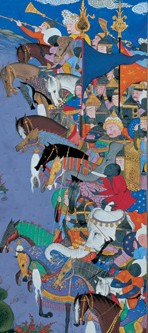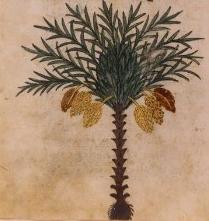
To next page
Al Marvazi: Kitab Taba'i al Hayawan (1120) (Book on Animals) from Persia.
-----------------------------------------------------
Taken from: Marvazi on China, the Turks and India 1942
Complete name: Sharaf al-Zaman Tahir Marvazi
Also called: Al Marwazi
He took his information from a missing geographical work from Al-Jayhani
On the Habasha:
The Habasha (Ethiopians) are a category under which come different classes of people such as the Nubians, Zanj, etc.. Their territories consist of extensive countries with a wide-stretching periphery the extremity of which ends where habitation ends and cultivation and procreation ceases.....
As for the heat in the lands of Habasha and Zanj, it reaches the extreme limit in scorching. They find beauty in the intensity of blackness and abhor whiteness and hold that a white man cannot be healthy. There are some among them who eat the whites. Some people prefer the blacks to the whites. What led them to this assumption was the fact that they had seen many Arabs and Indians who possessed an abundant share of spiritual and physical gifts and whose complexion was blackish, as they also had seen that, if some whites had black moles, it added to their beauty and pleasantness....
It is said in the Tawarikh (Histories) that one of the kings of Khorasan crossed the Oxus in order to fight the Turks. In his troops there were some Zanj. When the Turks sallied forth to meet them, they saw the Zanj, whose appearance frightened them, for they imagined that they were demons or some other kind of supernatural beings. So they put to flight and retreated without fighting. When the kings of Khorasan were informed of this they increased the numbers of Zanj and Habasha and put them forward in fighting the Turks. Bur finally the Turks got accustomed to seeing the Zanj, and killing one of them saw that his blood was red. So they said; His blood is like human blood and so are his limbs, and their fear ceased.
In the Tarikh Muluk al-Turk (History of Turkish Kings) it is related that one of them called B.K.J. became related by marriage to the king called Jabbuya. Among the dowry and numerous gifts which he dispatched to him was a Zanj porter who was a wonder among the white. They used to bring him to their assemblies and express their astonishment in looking at his appearance and color. He possessed (great) sagacity, power of thought and valor, and he succeeded in performing many great deeds. The king attached him to his person and his station continuously grew in elevation and solidity. Finally he attacked the king, killed him, occupied his place and seized most of their provinces. He assumed the title of Qara-Khan, which no one had held before him, for it means Black Khaqan. His dignity was great, so whenever the Turks after him wished to honor a king they addressed him as Qara-khan, in Turkish qara being black and khaqan Supreme lord. So Qara-khan means Black Khaqan.
In the farthest lands of the Zanj there is a tribe of theirs living on the sea-coast and having no buildings, fields or animals. heat oppresses them excessively. They have underground dwellings which they dig out and make deep. At day time they take refuge in these dwellings, which they cannot leave until at sunset the sun has shrunk. Their food is fish, fruit and trees. Their lands include meadows and intertwined trees. They are of ugly appearance and extremely tall, with flapping lips, lop-eared, with wide ear apertures and nostrils. They eat the flesh of the whites whom they have vanquished. It is their custom after a victory over some whites to imprison them on an island of theirs lying in the sea and give them food in abundance of whatever there is in their possession, so that their bodies fatten and their flesh increases, after which they slaughter them and eat them. Their king and queen have special rights to this dish, but if it is plentiful other persons partake of it. On account of their heat they are hard pressed by lust. Sometimes, when the whites are brought before the king that he may make his choice of whom he wants to be slaughtered, the queen's eyes fall on someone whom she finds good and she selects him as food for herself, takes him into her underground dwelling and dallies with him. If she discovers in him strength and mastery in coition, she spares him, cares for him and feeds him with the kind of fish which increases sexual power. She continues to avail herself of his services until he grows weak and tired, and when he becomes impotent she kills and eats him. Sometimes the man seizes an opportunity and runs away.

Taken from: A doctor�s book on zoology: Al Marwazi�s Taba�I Al-Hayawan (Nature of Animals) by Albert Z. Iskandar in Oriens vol 27 1981
Some say that the giraffe is an offspring of the tiger and the camel. Nevertheless I have not seen any resemblance between (the giraffe) and the tiger. A giraffe, said to be of the best variety, was brought in the presence of Sultan Malik-Shah. I saw it in Isfahan in the year 1081-82. The vizier Nizam al Mulk ordered me to observe the giraffe and to contemplate its figure and form. I thought it was an amazing sight.......
Harmony...in a Zanj is that he should be black, tall in stature, with large eyes, nostrils and corners of the mouth, with crisp hair and harsh voice, whereas a Turk should be short, with narrow eyes, nostrils and mouth, and a shrill voice. If a Zanji had the characteristics (kayfiya) of a Turk, or vice versa, this would be an anomaly. Each nation, nay each person has a special constitution (mizaj)